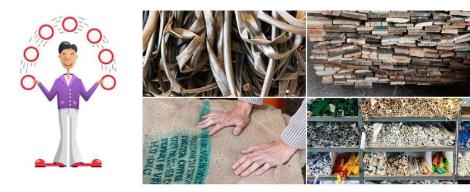The circular economy, a model for ecological transition
Bulletin No. 115
May 2022
Faced with the increasing scarcity of natural resources and the imperative of ecological transition, the concept of the circular economy is gradually gaining ground. It is becoming a new development model that breaks with the traditional linear model of ‘extract, manufacture, consume, dispose’ in favour of a circular approach. The aim is to achieve resource-efficient and effective management in order to limit environmental impacts.
As part of its partnerships, ADP Villes en Développement is opening its newsletter to the French Development Agency. The AFD is publishing below a text co-signed by Hassan Mouatadid, Deputy Head of its Urban Development, Housing and Planning Division, Jonas Byström, Senior Engineer in the Circular Economy Division of the European Investment Bank (EIB), and Philippe Masset, Director for Europe and International Affairs at ADEME, the French agency for ecological transition.

The circular economy: a necessity
In 2020, a report by the International Resource Panel (IRP) predicted a gradual doubling of demand for natural resources (excluding water) by 2060, reaching 19 tonnes per capita per year. Most of this increase would be in construction and industrial materials. In light of this, a change of model seems essential.
In 2011, the United Nations Environment Programme (UNEP) stated that a sustainable linear system would require individual consumption to be limited to 3–6 tonnes per capita per year by 2060, which seems economically unimaginable. The UN therefore recommended focusing more on the ‘efficient’ use of resources.
The extraction and processing of materials and fuels account for 53% of global greenhouse gas (GHG) emissions. Experts say that the growth in demand for raw materials between now and 2060 will contribute to a 43% increase in GHG emissions. Resource extraction and processing are also responsible for 90% of the world’s biodiversity and water losses.
The circular economy: moving towards reality
While the European Union defines the circular economy as ‘a model of production and consumption that involves sharing, reusing, repairing, renovating and recycling existing products and materials for as long as possible so that they retain their value’, ADEME specifies that its application contributes to ‘reducing the impact on the environment while improving the well-being of individuals’. The agency identifies seven pillars of action grouped into three areas, which together form a cycle, with each step leading to the next.
Sustainable sourcing emphasises the duty of producers to consider the materials they use. For example, the Phenix digital app combats food waste by reselling unsold items.
Eco-design aims to offer products, services or processes that take into account their impact from creation to disposal. For example, CINE manufactures a household cleaner that contains fewer eco-toxic substances and is more biodegradable.
Industrial and territorial ecology creates chains of interdependence between economic production entities to optimise resource flows. For example, the ‘ecoréseau’ (eco-network) of Biotop companies and 162 other public and private partners pool their needs and waste, in particular by recycling PVC scraps and coffee bags or reusing big bags.
The functional economy promotes the sale of a service or the rental of a maintained product rather than the sale of a product as such. This allows customers to enjoy a product without owning it. For example, Forézienne MFLS manufactures cutting tools for mechanical woodworking, rents out its equipment and provides maintenance. To be economically viable, the lifespan of the equipment has been increased by 20%.
Responsible consumption requires each individual to make consumption choices that take into account the life cycle of goods and services. For example, evaluating and comparing products based on labels and indices and favouring products with a longer lifespan, even if they are more expensive, are among the key principles.
Extending the useful life of products encourages people to repair, donate or sell them instead of throwing them away. For example, Envie collects paramedical equipment, repairs it and donates or sells it at low prices to people in need.
Recycling should only be used for materials that cannot be reused. Although it is the most commonly considered option, it should be the last link in the chain in order to optimise the impact of the circular model.
The circular economy and sustainable cities
The circular economy appears in many respects to be a relevant and coherent approach to the challenges of the ‘sustainable city’. It is at the heart of the urban development strategy of international financial institutions, including the AFD and the EIB.
The circular economy is an essential response to the significant growth in global resource consumption, 70% of which is consumed in and by cities. Furthermore, cities can be the cradle of circular models. By 2030, 60% of the world’s population will live in cities. And increasing urbanisation should facilitate the development of these models.
The circular economy is also playing a new role in waste management and recycling by seeking to improve resource efficiency: extending product life cycles, giving products a second life, optimising the use of raw materials, etc. This approach makes it possible to limit waste production and optimise waste management, which is a major burden on local authorities’ budgets, particularly in developing countries.
Factors for change
The challenges and factors contributing to the implementation of a circular economy are technical, political, economic, sociological and human. Sociological and human factors are the most complex to activate. They require imagining different habits without consumers or producers seeing this as a step backwards. It is much more a question of accepting individual limitations for the benefit of the collective, redefining needs, adapting consumption accordingly and no longer linking consumption and ownership.
This complex paradigm requires us to rethink the way we do things, produce and act at several levels in favour of environmental, economic and social commons. Common values are therefore set to evolve, which will involve major changes in the world of work. Support for change and awareness-raising among decision-makers, producers, sellers and consumers will therefore be key to the adoption of this new framework.